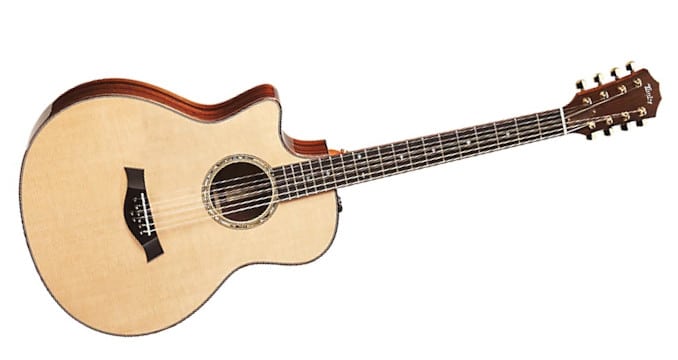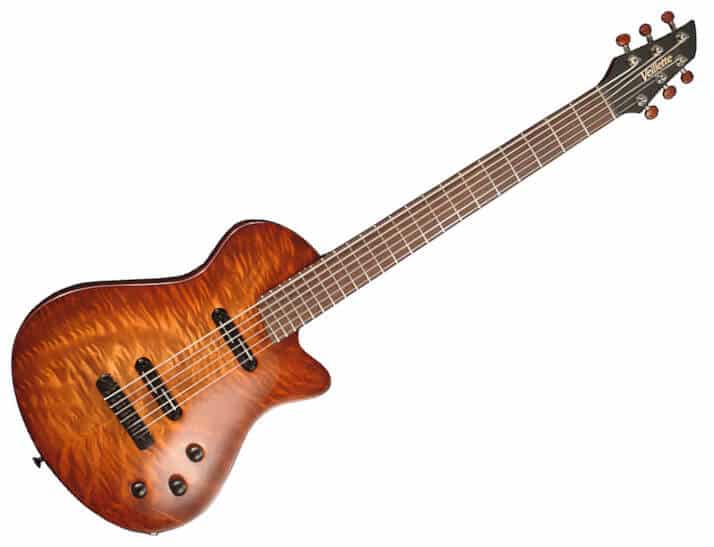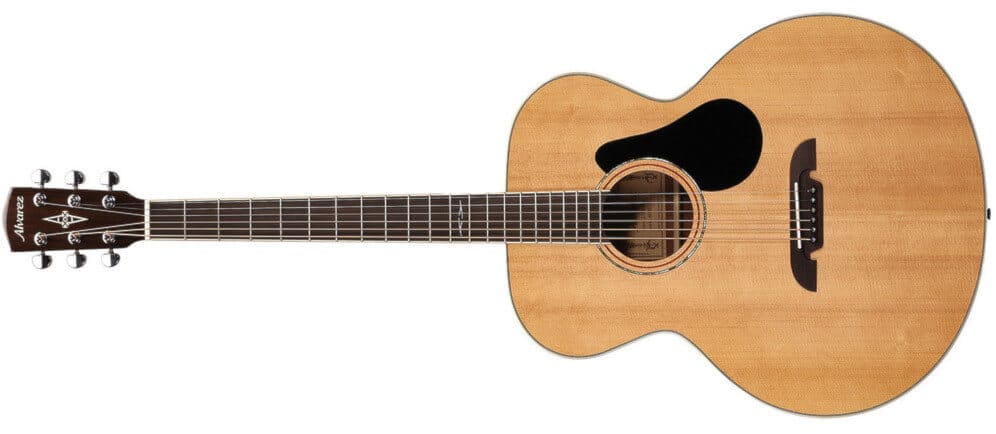Table of Contents
In a world where guitarists are constantly seeking new ways to express their creativity and expand their sonic palette, the baritone guitar emerges as a hidden gem waiting to be discovered.
This unusual instrument presents a fascinating avenue for musical discovery with its deep, rich tones. But how does a baritone guitar differ from its more traditional siblings, and what precisely is it?
In this Killer Rig article, we’ll look into the fascinating world of extended-range instruments, uncovering the characteristics and versatile applications of the baritone guitar.
Are you ready to venture beyond the familiar realm of standard guitars and unlock a new dimension of musical expression? Then read on and be prepared to have your musical horizons broadened!
What is a Baritone Guitar?
A baritone guitar is a six-stringed instrument with a longer scale length. It’s tuned lower than a standard guitar, most commonly to B-B or C-C, and features heavier gauge strings.
Its unmistakable tuning provides a deeper, richer sound, making it versatile across many genres like rock, jazz, country, and metal. The baritone guitar is an exciting option for guitarists looking to explore new sonic territories and add depth to their music.
Differences Between the Baritone and Standard Guitars
While the baritone may look similar to a standard guitar at first glance, there are several key differences that set it apart:
- Neck and fretboard: Due to the longer scale length, the neck and fretboard of a baritone guitar are also longer and slightly wider, accommodating the increased distance between frets. This design not only caters to the lower tuning, but also offers a different feel and response when playing.
- Strings and their characteristics: Baritone guitars require heavier gauge strings to maintain proper tension and intonation at lower tunings. These thicker strings contribute to the instrument’s special tonal qualities, delivering a fuller, more powerful sound.
- Body size and construction: While the body size of a baritone guitar can vary depending on the manufacturer and model, the aim is to make them large. This is to enhance resonance and projection. Additionally, the internal bracing and construction may be adjusted to optimize the instrument’s performance at lower frequencies.

Anatomy of a Baritone Guitar
Understanding the anatomy of a baritone guitar is essential to appreciating its sound and capabilities. This extended-range instrument has several features that distinguish it from standard guitars.
With its improved scale length, specific tuning, and construction details that cater to its lower pitch.
Scale Length
The scale length, or the distance between the nut and the bridge, plays a significant role in determining the tone and playability of a guitar.
Baritone guitars typically have a longer scale length, ranging from 27 to 30.5 inches. This is much different when compared to the standard guitar’s 24.75 to 25.5 inches.
This extended scale length allows for lower tunings while maintaining string tension. It results in a richer, deeper tone and greater clarity in the lower register.
The increased string tension also makes for a tighter, more focused sound, with enhanced sustain and projection.
Tuning: Standard and Variations
The most common tuning for a baritone guitar is B-B. Meaning that it’s tuned a perfect fourth lower than a standard guitar (B-E-A-D-F#-B). This tuning allows for an extended lower range, providing a bridge between the standard and bass guitar territories.
However, some players may choose alternative tunings, such as C-C or even A-A. All to suit specific musical styles or personal preferences.
The versatility of the baritone guitar’s tuning options makes it a valuable asset for those looking to explore new tonal landscapes.
The Sound of a Baritone Guitar
The baritone guitar’s incredible sound is what sets it apart from others. This makes it an attractive choice for musicians seeking new tonal possibilities.
The most notable aspect of the baritone guitar’s sound is its rich, deep low-end presence. With its extended range and heavier strings, the instrument produces warm, resonant tones that can add depth and texture to any musical arrangement.
The baritone guitar’s tuning also allows for chord voicings and melodic lines that are not possible on a standard guitar.
Enabling musicians to explore new harmonic and melodic territories. Furthermore, the increased string tension contributes to a tight, focused sound with enhanced sustain and projection.
Making the baritone guitar versatile enough to excel in both rhythm and lead roles.
Baritone Sound Vs Other Extended-Range Instruments
The baritone guitar shares some similarities with other extended-range instruments. Such as the bass VI and the seven or eight-string guitar. But it maintains its own identity through its specific tuning and construction.
The bass VI, for example, is tuned an octave lower than a standard guitar. It’s often played more like a bass. Whereas, the baritone occupies a special sonic space between standard and bass guitars.
Seven and eight-string guitars, on the other hand, extend the range in both higher and lower registers. But their primary focus is typically on the lower strings for heavier, djent-style playing, which is not necessarily the case with the baritone guitar.
Popular Music and Artists
As mentioned earlier, the baritone guitar has found its place in various music genres. From rock and metal to jazz and experimental music. Its unique sound has allowed artists to experiment with new textures and expand their musical vocabulary.
Some notable examples include Tool, Mastodon, and Deftones in rock and metal. Pat Metheny and John Scofield in jazz and fusion. And Sonic Youth, My Bloody Valentine, and The Cure in alternative and experimental music.
These artists demonstrate the incredible versatility and creative potential of the baritone guitar, inspiring a new generation of musicians to explore its sonic possibilities.

Techniques and Tips
Due to the baritone guitar’s longer scale length and wider fret spacing, you may need to adjust your finger positioning. This will come by increasing your hand stretches to comfortably navigate the fretboard.
Start by practicing familiar scales and chords, paying close attention to your hand positioning and finger placement. The heavier strings and increased string tension on a baritone guitar may require you to adjust your picking and strumming techniques.
Experiment with different pick thicknesses and materials to find the right balance between attack and dynamics. Additionally, consider refining your pick angle and attack to achieve a clean and articulate sound.
Pay close attention to your fretting and picking hand muting techniques, using your palm and fingers to prevent unwanted string vibrations.
Exploring the Tonal Possibilities
The baritone’s specific tuning allows for chord voicings that are not possible on a standard guitar. Experiment with new fingerings and chord shapes to create harmonic textures and expand your chordal vocabulary.
The standard B-B tuning is the most common for baritone guitars. But don’t be afraid to explore alternate tunings to discover new sonic landscapes. Some popular options include C-C and A-A tunings. Or, even open tunings for slide playing.
The baritone’s tonal range makes it an excellent choice for complementing other instruments, such as standard guitars and basses. Experiment with layering parts and creating counter-melodies to fully utilize the baritone guitar’s sound in a band setting.
Tips for Effective Practice and Performance
- Familiarize yourself with the instrument: Spend time getting to know your baritone guitar inside and out! From its scale length and body shape to its electronics and hardware. This familiarity will help you feel more comfortable when playing and make it easier to adapt to the instrument’s specific characteristics.
- Develop a practice routine: Incorporate exercises and drills specifically designed for the baritone guitar into your practice routine. This will help you build strength, dexterity, and familiarity with the instrument’s extended range.
- Listen to baritone guitar players: Learning from accomplished baritone guitarists is an excellent way to pick up new techniques and ideas. Study the playing of artists from various genres to gain inspiration and insight into the instrument’s capabilities.
Choosing the Right Baritone Guitar
Selecting the perfect baritone guitar can be a daunting task! Especially with the plethora of options available on the market.
To make the decision-making process easier, it’s important to consider several factors that will help you find the right instrument for your needs and preferences.
Factors to Consider when Purchasing a Baritone
When choosing a baritone guitar, it’s essential to take the following factors into account:
- Scale length: Baritone guitars come in various scale lengths, typically ranging from 27 to 30 inches. The choice of scale length will affect the instrument’s tone, playability, and tuning stability. Consider which scale length will best suit your playing style and the kind of music you want to create.
- Body style: Baritone guitars are available in different body styles, including solid-body, semi-hollow, and hollow-body designs. Each style has its own tonal characteristics and aesthetic appeal. So think about which one aligns with your personal preferences and the sound you’re aiming for.
- Pickup configuration: The choice of pickups can greatly influence the tone of a baritone guitar. Common options include single-coil, humbucker, and P-90 pickups, each with its own sound. Consider the type of music you play and your desired tonal qualities when choosing a pickup configuration.
- Budget and brand preferences: Baritone guitars come at various price points, from budget-friendly options to high-end custom models. Set a budget for your purchase and research different brands to find a quality instrument that fits within your financial constraints.
Top Brands and Models
Several brands have established a solid reputation for producing quality baritone guitars. Some of the most popular options include:
- Fender: Known for their iconic instruments. Fender offers the Blacktop Baritone Telecaster. It features a 27-inch scale length, a versatile humbucker/single-coil pickup configuration, and classic Telecaster styling.
- PRS: Paul Reed Smith is another reputable brand offering baritone models, such as the PRS SE 277. It boasts a 27.7-inch scale length, a solid body design, and PRS-designed humbucker pickups.
- Ibanez: Ibanez has a diverse lineup of baritone guitars. Including the Ibanez RGIB6, which features a 28-inch scale length, a solid body design, and active EMG pickups for aggressive, high-output tones.
- Danelectro: Danelectro is known for its designs and affordable instruments. The Danelectro Baritone features a 29.75-inch scale length, a solid body, and their signature lipstick pickups, providing a particular tone and vintage vibe.
By carefully considering these factors and exploring different brands and models, you can find the ideal baritone guitar to meet your musical needs and unlock new creative possibilities.

Conclusion
The baritone guitar is a special and versatile instrument. It offers musicians the opportunity to explore new tonal possibilities and expand their creative horizons.
By choosing the right baritone guitar for your needs, incorporating new playing techniques, and drawing inspiration from other artists, you’ll be well-equipped to find your own sound with this instrument.
Embrace the challenge and enjoy the rewards of venturing into the extended range of this fascinating instrument.
FAQ
Is it worth getting a baritone guitar?
Absolutely, especially if you’re looking to explore new tonal possibilities or specific music genres such as jazz, metal, or country.
The baritone guitar’s specific tuning, larger scale length, and heavier strings can provide a richer, deeper sound that standard guitars cannot replicate.
It can also serve as a bridge between the sounds of a standard guitar and a bass guitar, adding versatility to your musical compositions.
Are baritone guitars good for beginners?
Baritone guitars can be more challenging for beginners due to their longer scale length and the increased distance between frets. This could require larger hand stretches and more finger strength.
However, if a beginner is dedicated and patient, they can certainly start their journey with a baritone. It may even provide them with a unique perspective on guitar playing.
Do baritone guitars need special strings?
Yes, baritone guitars typically require heavier gauge strings. This is necessary to maintain the correct tension and intonation due to the baritone’s longer scale length and lower tuning.
Do I need a baritone guitar for metal?
While a baritone is not a necessity for playing metal music, it can be an excellent addition to a metal guitarist’s arsenal.
The lower tuning and extended range of a baritone guitar can provide the heavier, deeper sounds that are often prevalent in metal music.
However, many metal genres can also be played effectively on standard or extended-range guitars, like seven or eight-string models.

